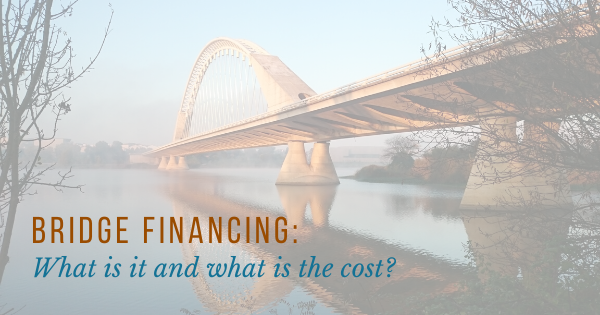So what is bridge financing?
Simply put, bridge financing is a loan for the down payment for your new home, before the you close on your existing property sale. If you are taking possession of your new property before the sale of your existing home closes, and down payment is coming from the proceeds of that sale, then bridge financing is required.
What you need to know
It’s a challenge to get the closing dates of purchase and sale to line up. Moreover, who would want to? There is so much work in packing, moving, and cleaning. It’s far less stressful to spread those dates out so you move into your new home and have time to get your existing property properly cleaned for the new owners. This is where bridge financing comes in.
The most important element of bridge financing is the requirement for a firm sale on your existing property. This means that all conditions of sale must be removed by the new buyer. The purpose is to cover the down payment on the new property until you receive the proceeds from the sale of your current home. The purpose is not to cover you indefinitely while you try to sell your property.
Most lenders offer bridge financing options, but not all. Make sure you discuss the need for bridge financing with your mortgage broker before you remove conditions of the purchase of your new home, in the event you need to make changes to any dates.
Remember that your down payment includes the deposit that is being held in trust on the new property. Because these funds have already been paid, they are not included in the interim financing requirement. So, if the total down payment is $100,000 and the deposit is $10,000, the bridge loan would be provided for $90,000.
Additionally, the majority of lenders allow bridge financing for up to 120 days (essentially four months). Most homebuyers are looking for bridge for only a few days or a couple of weeks, but there are extenuating circumstances. Again, it’s important to have a conversation with your mortgage broker about any limitations.
The cost of bridge financing
Bridge financing rates are based on the Prime Rate and usually run in the Prime plus two per cent to Prime plus six per cent range. This sounds like a lot, but it’s really not. The rate is stated as an annual rate but it’s a simple, daily interest loan.
Based on a Prime Rate of 2.95% (Prime as at 13 Mar 2020), here is an example of the cost of bridge financing. I have used the higher end of the rate range above and two different time frames for illustration purposes:
| Funds required for Bridge | $ 90,000 | $ 90,000 |
| Days of Bridge Required | 1 | 14 |
| Rate for Bridge | 8.95% | 8.95% |
| TOTAL COST OF BRIDGE | $ 22.05 | $ 308.75 |
Most lenders charge an administration fee for bridge. This fee ranges from $200-500 dollars.
In addition to the direct cost of the bridge financing, there is also the cost of carrying both mortgages for the interim period. For example, if you take possession of your new home on April 1 and the sale of your existing property closes on April 5, you will be carrying both mortgages for those five days.
For more information about juggling the sale of your current home while you search for your new home, check out this blog post. If you have any additional questions, please don’t hesitate to reach out!



Very interesting info !Perfect just what I was searching for!
shielahua@gmail.com